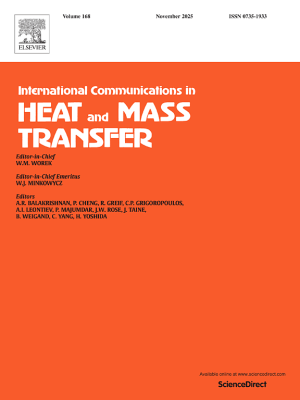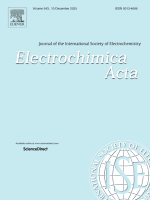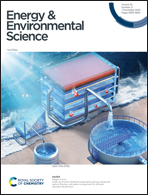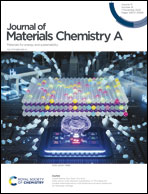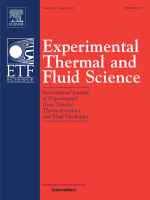-
4 Nov 2025 • Journal Article • International Communications in Heat and Mass Transfer
A numerical study of intra-catalyst diffusion limitations in small-scale ammonia plate reformer
AbstractAmmonia is an efficient hydrogen carrier that can be easily converted into H -rich gas. In this study, a numerical investigation of the ammonia decomposition process within a small-scale plate reformer is presented to understand the effect of catalyst layer thickness on intra-catalyst diffusion limitations. Simulations
… show more -
1 Nov 2025 • Journal Article • Journal of Turbomachinery
Transonic Linear Cascade Demonstration of Acoustic Flow Control on High Work and Lift Turbines
AbstractAbstract. The study explores acoustic flow control in high-lift, high-work turbine blades (L3FHW and L4FHW) tested in a transonic linear cascade facility to tackle flows with open separations at low Reynolds numbers caused by high adverse pressure gradients. Acoustic excitation aims to focus on frequencies associated with the Kelvin–Helmholtz instability, which scales
… show more -
30 Oct 2025 • Journal Article • Science
Porous materials: The next frontier in energy technologies
AbstractPorous materials with pore sizes spanning the range from molecular to macroscopic dimensions (from angstroms to centimeters) are essential in electrochemical, thermoelectric, nuclear, and solar power sources and in the extraction of oil, gas, and geothermal heat. To enable the clean, fast, and efficient conversion of energy, the porous structure must be designed to
… show more -
30 Oct 2025 • Journal Article • Electrochimica Acta
Towards dual-purpose water-energy systems: Modeling hydrogen–oxygen desalination fuel cells
AbstractThe desalination fuel cell (DFC) represents a novel electrochemical technology that simultaneously desalinates water and generates electricity by coupling oxidation–reduction reactions. This study introduces a theoretical framework to support experimental findings and further elucidates DFC performance mechanisms. Unlike traditional electrodialysis (ED), where an
… show more
-
21 Oct 2025 • Journal Article • Energy & Environmental Science
Activating Ni atoms up to the third nearest neighbor around single-atom Fe into highly active sites for PGM-free anion-exchange membrane fuel cells
AbstractAnion exchange membrane fuel cells (AEMFCs) have attracted much attention due to their bipolar design that enables the use of all Pt-group metal (PGM)-free catalysts. As the only PGM-free metal with the anode hydrogen oxidation reaction (HOR), the performance of Ni-based metals in fuel cells is too low to match well with the cathode oxygen reduction reaction (ORR) due
… show more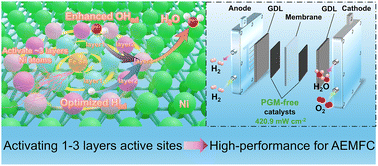
-
21 Oct 2025 • Journal Article • Journal of Materials Chemistry A
Does the presence of CO2 affect the alkaline stability of anion-exchange membranes?
AbstractAnion-exchange membranes (AEMs) enable electrochemical energy devices to operate in alkaline environments, allowing the use of earth-abundant, platinum group metal-free catalysts. This makes them highly attractive for applications such as AEM fuel cells (AEMFCs), water electrolyzers (AEMWEs), and oxygen separators (AEMOSs). However, two key challenges still hinder their
… show more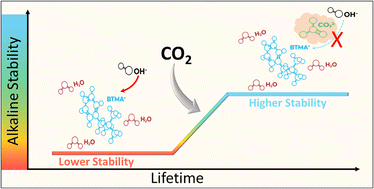
-
20 Oct 2025 • Preprint
The agentic age of predictive chemical kinetics
AbstractPredictive chemical kinetic modeling is foundational to areas ranging from energy and environmental science to pharmaceuticals and advanced materials. While significant progress has been made in automating individual steps, the development of a complete predictive model remains a human-intensive effort to orchestrate existing software tools and revise models. This
… show more -
17 Oct 2025 • Journal Article • Energy Storage and Applications
Comparative Analysis of Optimal Control and Reinforcement Learning Methods for Energy Storage Management Under Uncertainty
AbstractThe challenge of optimally controlling energy storage systems under uncertainty conditions, whether due to uncertain storage device dynamics or load signal variability, is well established. Recent research works tackle this problem using two primary approaches: optimal control methods, such as stochastic dynamic programming, and data-driven techniques. This work’s
… show more
-
17 Oct 2025 • Journal Article • Experimental Thermal and Fluid Science
Mixing and entrainment of liquid fuel in a cavity-based scramjet model combustor
AbstractThis work quantitatively investigates liquid fuel mixing and entrainment in a cavity-based scramjet model combustor, focusing on potential and limitations of using an infrared imaging-based measurement technique. The proposed approach produces time-averaged path density maps that enable characterization of fuel distribution in a high-enthalpy supersonic crossflow. Using
… show more -
16 Oct 2025 • Preprint • bioRxiv
The bacterial schizorhodopsins: novel light-driven inward proton pumps from Antarctic Minisyncoccota (Patescibacteria) and cyanobacteria, with implications for the proton-pumping mechanism
AbstractMicrobial rhodopsins represent a diverse superfamily of light-sensitive seven-transmembrane proteins with expanding phylogenetic diversity driven by advances in metagenomics. Among these, schizorhodopsins constitute a divergent family originally identified as inward proton pumps from Promethearchaeota (Asgard archaea). Here, we report that in addition to archaeal
… show more
